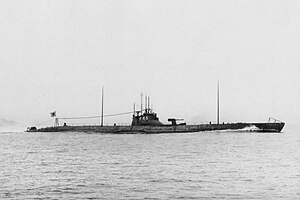
The Guadalcanal campaign, also known as the Battle of Guadalcanal and codenamed Operation Watchtower by the United States, was an Allied offensive against forces of the Empire of Japan in the Solomon Islands during the Pacific Theater of World War II. It was fought between 7 August 1942 and 9 February 1943, and involved major land and naval battles on and surrounding the island of Guadalcanal. It was the first major Allied land offensive against Japan during the war.

The Naval Battle of Guadalcanal, sometimes referred to as the Third and Fourth Battles of Savo Island, the Battle of the Solomons, TheBattle of Friday the 13th, The Night of the Big Guns, or, in Japanese sources, the Third Battle of the Solomon Sea, took place from 12 to 15 November 1942 and was the decisive engagement in a series of naval battles between Allied and Imperial Japanese forces during the months-long Guadalcanal campaign in the Solomon Islands during World War II. The action consisted of combined air and sea engagements over four days, most near Guadalcanal and all related to a Japanese effort to reinforce land forces on the island. The only two U.S. Navy admirals to be killed in a surface engagement in the war were lost in this battle.
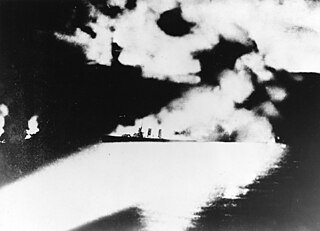
The Battle of Savo Island, also known as the First Battle of Savo Island and in Japanese sources as the First Battle of the Solomon Sea, and colloquially among Allied Guadalcanal veterans as the Battle of the Five Sitting Ducks, was a naval battle of the Solomon Islands campaign of the Pacific War of World War II between the Imperial Japanese Navy and Allied naval forces. The battle took place on 8–9 August 1942 and was the first major naval engagement of the Guadalcanal campaign and the first of several naval battles in the straits later named Ironbottom Sound, near the island of Guadalcanal.

USS John D. Ford (DD-228/AG-119) was a Clemson-class destroyer in the United States Navy during World War II. She was named for Rear Admiral John Donaldson Ford.

Shikinami was the 12th of 24 Fubuki-class destroyers, built for the Imperial Japanese Navy following World War I. When introduced into service, these ships were the most powerful destroyers in the world. They served as first-line destroyers through the 1930s, and remained formidable weapons systems well into the Pacific War.

There was considerable Axis naval activity in Australian waters during the Second World War, despite Australia being remote from the main battlefronts. German and Japanese warships and submarines entered Australian waters between 1940 and 1945 and attacked ships, ports and other targets. Among the best-known attacks are the sinking of HMAS Sydney by a German raider in November 1941, the bombing of Darwin by Japanese naval aircraft in February 1942, and the Japanese midget submarine attack on Sydney Harbour in May 1942. About 40 Allied merchant ships were damaged or sunk off the Australian coast by surface raiders, submarines and mines. Japanese submarines also shelled three Australian ports and submarine-based aircraft flew over several Australian capital cities.
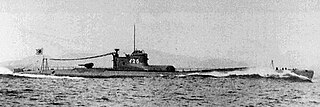
I-26 was an Imperial Japanese Navy B1 type submarine commissioned in 1941. She saw service in the Pacific War theatre of World War II, patrolling off the West Coast of Canada and the United States, the east coast of Australia, and Fiji and in the Indian Ocean and taking part in Operation K, preparatory operations for the Aleutian Islands campaign, and the Guadalcanal campaign, the Marianas campaign, and the Battle of Leyte Gulf. She was the first Japanese submarine to sink an American merchant ship in the war, sank the first ship lost off the coast of State of Washington during the war, damaged the aircraft carrier USS Saratoga (CV-3), sank the light cruiser USS Juneau (CLAA-52), and was the third-highest-scoring Japanese submarine of World War II in terms of shipping tonnage sunk. Her bombardment of Vancouver Island in 1942 was the first foreign attack on Canadian soil since 1870. In 1944, I-26′s crew committed war crimes in attacking the survivors of a ship she sank. She was sunk in November 1944 during her ninth war patrol.

Kinugasa (衣笠) was the second vessel in the two-vessel Aoba class of heavy cruisers in the Imperial Japanese Navy. The ship was named after Mount Kinugasa, located in Yokosuka, Kanagawa, Japan.

Sendai was a Sendai-class light cruiser in the Imperial Japanese Navy. She was named after the Sendai River in southern Kyūshū. Sendai was the lead ship of the three vessels completed in her class of light cruisers, and like other vessels of her class, she was intended for use as the flagship of a destroyer flotilla.
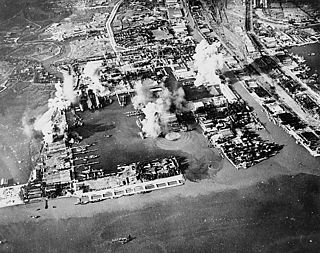
Operation Transom was an attack by Allied forces against the Japanese-occupied city of Surabaya on the Indonesian island of Java during World War II. Conducted by the British-led Eastern Fleet, the operation took place on 17 May 1944 and involved American and British carrier-based aircraft bombing the city's docks and an oil refinery. An American torpedo bomber was shot down, and two British torpedo bombers were lost in accidents.
The Shelling of Newcastle was conducted by the Japanese submarine I-21 in the early hours of 8 June 1942. The bombardment followed the attack on Sydney Harbour on 31 May, and was conducted shortly after I-24 shelled the Eastern Suburbs of Sydney. During the attack I-21 fired 34 shells at Newcastle, including eight illumination rounds, but caused little damage. The Australian gunners at Fort Scratchley fired four shells at the submarine, but scored no hits.

The 8th Fleet was a fleet of the Imperial Japanese Navy (IJN) established during World War II.
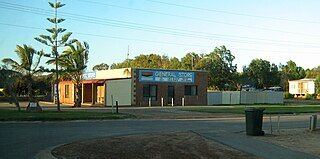
Gregory is a small town and fishing port located 7 km (4.3 mi) northwest of the mouth of the Hutt River, in the Mid West region of Western Australia. At the 2016 census, Gregory had a population of 64 in 83 dwellings. Most of the dwellings are holiday houses. The population of Gregory fluctuates depending on tourism; with the town at full capacity during school holidays and throughout the summer. During the census 50% of dwellings were unoccupied.

During March 1944, the Allies of World War II rapidly reinforced the military units located in the state of Western Australia to defend against the possibility that Japanese warships would attack the cities of Fremantle and Perth. This redeployment began on 8 March after concerns were raised about the purpose of Japanese warship movements near the Dutch East Indies, and ended on 20 March, after it was concluded that an attack was unlikely.

The Second Battle of Durazzo, or the Bombardment of Durazzo was a naval battle fought in the Adriatic Sea during the First World War. A large allied fleet led by the Regia Marina attacked the enemy-held port at Durazzo, Albania. The fleet destroyed the Austro-Hungarian shore defenses and skirmished with a small naval force. Allied forces involved primarily were Italian though British, American and Australian warships also participated. It was the largest naval battle the United States participated in during the war. Most of the city was destroyed in the bombardment.

The allied naval bombardments of Japan took place during the last weeks of the Pacific War in 1945, in which warships of the United States Navy, the Royal Navy and the Royal New Zealand Navy bombarded industrial and military facilities in Japan. Most of these bombardments were conducted by battleships and cruisers, and caused heavy damage to several of the targeted factories, as well as nearby civilian areas. A major goal of the attacks was to provoke the Japanese military into committing some of its reserve force of aircraft into battle. However, the Japanese did not attempt to attack the Allied bombardment forces, and none of the involved warships suffered any damage.
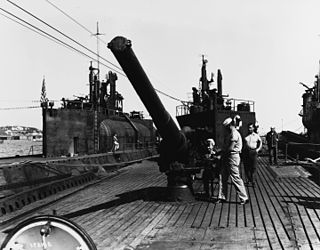
The 14 cm/40 11th Year Type naval gun was the standard surface battery for Japanese submarine cruisers of World War II. Most carried single guns, but Junsen type submarines carried two. Japanese submarines I-7 and I-8 carried an unusual twin mounting capable of elevating to 40°. The appended designation 11th year type refers to the horizontal sliding breech block on these guns. Breech block design began in 1922, or the eleventh year of the Taishō period in the Japanese calendar. The gun fired a projectile 14 centimeters (5.5 in) in diameter, and the barrel was 40 calibers long.

I-65, later renumbered I-165, was an Imperial Japanese Navy Kaidai type cruiser submarine commissioned in 1932. A KD5 sub-class submarine, she served during World War II, supporting Japanese forces in the invasion of Malaya and the Dutch East Indies campaign, participating in the Battle of Midway, and patrolling in the Indian Ocean and Pacific Ocean before she was sunk in 1945. In 1944, her crew committed a war crime, massacring the survivors of the merchant ship Nancy Moller.
I-62, later I-162, was a Kaidai-class cruiser submarine of the KD4 sub-class built for the Imperial Japanese Navy (IJN) during the 1920s and completed in 1930. She served throughout World War II, supporting the Japanese invasion of Malaya, taking part in the Battle of Midway, carrying out diversionary operations in support of the evacuation of Japanese forces from Guadalcanal, and conducting war patrols in the Indian Ocean. Late in the war, she became involved in supporting and training for kaiten suicide attack torpedo operations. She surrendered to the Allies at the end of the war in 1945, and the United States Navy scuttled her in 1946.
I-3 was an Imperial Japanese Navy J1 type submarine commissioned in 1926. She was a large cruiser submarine. She served in the Second Sino-Japanese War and World War II. During the latter conflict she operated in support of the attack on Pearl Harbor, conducted anti-shipping patrols in the Indian Ocean, supported the Indian Ocean raid, and took part in the Aleutian Islands campaign and the Guadalcanal campaign before she was sunk in December 1942.
